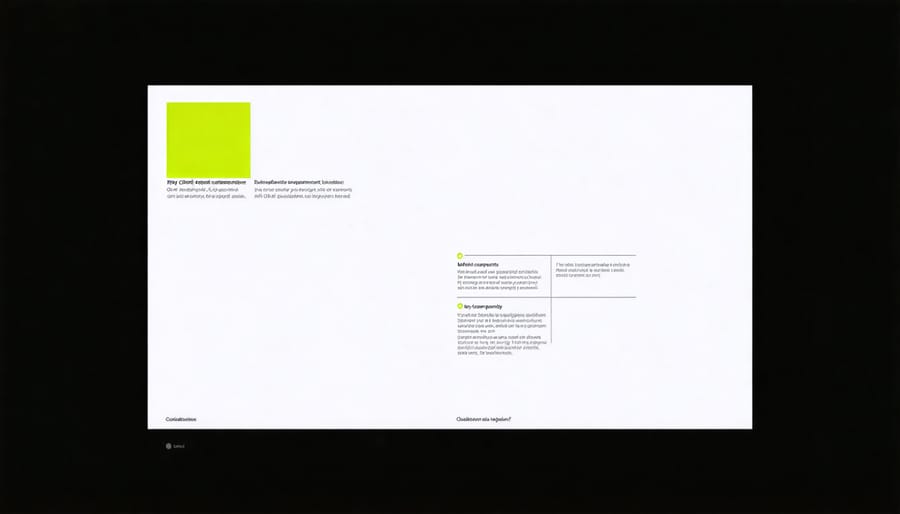Workplace safety compliance directly impacts operational efficiency, employee well-being, and financial stability across construction operations. Recent OSHA data reveals that companies with robust safety compliance programs reduce workplace incidents by 85% while achieving 40% lower insurance premiums. Yet, despite these compelling statistics, 65% of construction firms struggle to maintain consistent safety standards.
Modern workplace safety compliance demands a strategic blend of regulatory adherence, technology integration, and proactive risk management. Construction leaders must navigate an increasingly complex landscape of federal, state, and local requirements while implementing practical solutions that protect workers without compromising productivity. The stakes are particularly high in today’s environment, where a single serious safety violation can result in penalties exceeding $145,000 and potentially devastating reputational damage.
This comprehensive approach to safety compliance isn’t merely about avoiding penalties—it’s about creating a sustainable competitive advantage. Industry leaders demonstrate that effective safety programs consistently deliver measurable returns through reduced downtime, improved worker retention, and enhanced project delivery capabilities. As construction technologies and regulatory requirements continue to evolve, maintaining robust safety compliance has become fundamental to operational excellence and long-term business success.
Key Regulatory Requirements for Construction Sites
OSHA Standards and Requirements
The Occupational Safety and Health Administration (OSHA) maintains strict oversight of construction workplace safety through comprehensive OSHA construction regulations that every project must follow. These standards encompass crucial areas including fall protection (29 CFR 1926.500), scaffolding requirements (29 CFR 1926.451), and proper personal protective equipment (PPE) usage (29 CFR 1926.95).
Construction employers must ensure compliance with OSHA’s Fatal Four focus areas: falls, struck-by incidents, electrocutions, and caught-in/between accidents. This includes maintaining proper guardrail systems for elevated work surfaces, implementing comprehensive fall protection programs for heights exceeding 6 feet, and ensuring proper training for all equipment operators.
Site-specific safety plans must address hazard communication, emergency procedures, and regular safety inspections. OSHA requires documented training records, regular toolbox talks, and immediate reporting of any workplace incidents resulting in serious injury or fatality.
Recent updates to OSHA standards have emphasized silica dust exposure prevention, requiring engineering controls such as wet cutting methods or vacuum dust collection systems. Additionally, employers must implement heat illness prevention programs when temperatures exceed specific thresholds, including provisions for water, rest, and shade.
Non-compliance can result in substantial penalties, with current OSHA fines reaching up to $145,027 per willful or repeated violation. Regular internal audits and third-party safety consultations are recommended to maintain compliance and protect worker safety.

Local and State-Specific Regulations
While federal OSHA standards establish baseline requirements, local and state jurisdictions often impose additional construction safety regulations that reflect regional challenges and priorities. California’s Cal/OSHA, for instance, maintains stricter heat illness prevention protocols and seismic safety requirements than federal standards, while New York’s Industrial Code Rule 23 implements specific requirements for construction, demolition, and excavation work in urban environments.
Construction firms operating across multiple jurisdictions must navigate these varying requirements effectively. States like Washington and Oregon have developed comprehensive fall protection standards that exceed federal OSHA requirements, particularly for residential construction. Meanwhile, states such as Texas allow companies to opt out of workers’ compensation insurance, necessitating alternative safety and liability protocols.
Project managers should maintain updated compliance matrices for each jurisdiction where they operate, accounting for:
– Local building codes and permits
– State-specific training requirements
– Regional environmental considerations
– Municipal safety inspection schedules
– Special requirements for historic districts
Regular consultation with local authorities and safety consultants helps ensure compliance with evolving regulations. Many states also offer compliance assistance programs through their departments of labor, providing valuable resources for staying current with regional requirements. Companies should incorporate these variations into their safety management systems and training programs to maintain consistent compliance across operations.
Implementation Strategies for Safety Compliance
Safety Management Systems
A Safety Management System (SMS) serves as the cornerstone of effective workplace safety compliance, providing a structured approach to managing occupational risks and hazards. This comprehensive framework integrates various critical safety standards with operational procedures to create a cohesive safety ecosystem.
The key components of an effective SMS include policy development, risk assessment protocols, safety training programs, incident reporting mechanisms, and continuous improvement processes. Organizations must establish clear safety objectives, allocate necessary resources, and define roles and responsibilities across all organizational levels.
Implementation typically follows a Plan-Do-Check-Act (PDCA) cycle, ensuring systematic execution and evaluation of safety initiatives. This includes regular safety audits, performance monitoring, and data analysis to identify trends and areas for improvement.
Modern SMS frameworks increasingly incorporate digital solutions, such as safety management software and mobile applications, to streamline documentation, enhance communication, and ensure real-time compliance monitoring. These tools enable better tracking of safety metrics, automated reporting, and more efficient resource allocation.
Success in SMS implementation relies heavily on management commitment, employee engagement, and regular review of safety performance indicators. Organizations should focus on creating a positive safety culture where all stakeholders actively participate in maintaining workplace safety standards and contributing to continuous improvement efforts.
Training and Documentation Requirements
Effective workplace safety compliance hinges on comprehensive training programs and meticulous documentation practices. Organizations must establish structured training schedules that cover both mandatory safety requirements and job-specific hazard prevention. Initial safety orientation for new employees should address fundamental workplace safety protocols, emergency procedures, and proper use of personal protective equipment (PPE).
Regular refresher courses are essential, particularly for high-risk operations and when new equipment or procedures are introduced. Training programs should include hands-on demonstrations, interactive sessions, and competency assessments to ensure thorough understanding and retention of safety protocols.
Documentation requirements encompass multiple elements: detailed training records, incident reports, safety meeting minutes, equipment inspection logs, and hazard assessments. Organizations must maintain systematic record-keeping systems that track employee participation, certification expiration dates, and training effectiveness evaluations.
Digital documentation systems have become increasingly valuable for maintaining compliance records, offering features like automated reminder systems for certification renewals and real-time access to safety documentation. These systems help organizations demonstrate due diligence during regulatory inspections and maintain transparent safety records.
Organizations should also implement a verification process to ensure training effectiveness, including post-training assessments and periodic safety audits. This approach helps identify knowledge gaps and areas requiring additional focus, enabling continuous improvement of safety training programs while maintaining regulatory compliance.
Risk Assessment and Mitigation
Effective risk assessment and mitigation form the cornerstone of workplace safety compliance in construction. The process begins with systematic hazard identification through comprehensive site audits, employee feedback channels, and historical incident analysis. Construction managers must evaluate risks using both qualitative and quantitative methods, considering factors such as probability, severity, and exposure frequency.
A robust risk assessment framework should align with established safety quality standards while incorporating site-specific variables. Key strategies include:
1. Regular workplace inspections using standardized checklists
2. Implementation of Job Hazard Analysis (JHA) for high-risk tasks
3. Real-time monitoring systems for environmental conditions
4. Documentation and tracking of near-miss incidents
Once risks are identified, prioritize mitigation measures using the hierarchy of controls: elimination, substitution, engineering controls, administrative controls, and personal protective equipment (PPE). This systematic approach ensures resources are allocated effectively while maximizing risk reduction.
Successful mitigation requires continuous monitoring and adjustment. Establish key performance indicators (KPIs) to measure the effectiveness of control measures, and maintain detailed records of all assessment activities. Regular review and updates of risk assessment protocols ensure they remain relevant as project conditions evolve and new hazards emerge.
Technology and Tools for Safety Compliance
Digital Safety Management Platforms
Modern safety compliance management has evolved significantly with the adoption of digital platforms designed specifically for construction safety oversight. These comprehensive software solutions streamline compliance processes, automate documentation, and provide real-time monitoring capabilities essential for today’s complex construction environments.
Leading digital platforms integrate multiple safety functions, including incident reporting, hazard assessments, training management, and regulatory compliance tracking. Cloud-based systems enable instant access to safety protocols, permits, and certifications across multiple project sites, while mobile applications allow field workers to report incidents and access safety information immediately.
Key features of these platforms typically include:
– Digital safety inspection checklists and audits
– Automated compliance reporting and deadline tracking
– Employee training management and certification tracking
– Real-time incident reporting and investigation tools
– Risk assessment and hazard identification modules
– Document control and version management
– Analytics and trend analysis capabilities
Implementation of these systems has shown significant benefits, including reduced incident rates, improved compliance scores, and enhanced operational efficiency. Construction companies report up to 45% reduction in safety-related administrative time and a 30% improvement in hazard identification and resolution speed.
When selecting a safety management platform, organizations should consider factors such as scalability, integration capabilities with existing systems, mobile accessibility, and user interface simplicity. The platform should also accommodate specific industry requirements and regulatory standards while providing robust data security measures.

Wearable Safety Technology
Wearable safety technology has revolutionized workplace safety monitoring in the construction industry, offering real-time protection and data-driven insights. Smart personal protective equipment (PPE) now incorporates sensors and IoT connectivity to monitor vital signs, environmental conditions, and potential hazards.
Advanced hard hats equipped with proximity sensors alert workers to dangerous machinery or restricted zones, while smart safety vests monitor heart rate, body temperature, and worker movement patterns. These devices can immediately notify supervisors if a worker falls or becomes immobile, enabling rapid emergency response.
Gas detection wearables provide continuous monitoring of harmful substances and automatically alert workers when exposure limits are exceeded. Smart safety glasses with augmented reality capabilities can display critical safety information, work instructions, and hazard warnings directly in the worker’s field of view.
Biometric monitoring devices track fatigue levels and stress indicators, helping prevent accidents caused by worker exhaustion. The data collected from these devices also enables safety managers to identify patterns and potential risk areas, leading to more effective safety protocols and targeted training programs.
Several construction firms report up to 40% reduction in workplace incidents after implementing wearable safety technology programs. However, successful implementation requires careful consideration of privacy concerns, proper training, and integration with existing safety management systems. Companies should develop clear policies regarding data collection and usage while ensuring workers understand the benefits of these safety-enhancing tools.

Case Study: Successful Safety Compliance Implementation
Turner Construction’s implementation of a comprehensive safety compliance program at their $500 million healthcare facility project in Boston serves as a prime example of effective workplace safety management. The project, completed in 2021, demonstrated how strategic planning and technological integration can dramatically improve safety outcomes.
The company implemented a three-tiered approach to safety compliance. First, they established a digital documentation system that streamlined safety reporting and incident tracking. This resulted in a 45% reduction in documentation time and enabled real-time hazard identification and response.
Second, Turner introduced mandatory daily toolbox talks and weekly safety training sessions, incorporating virtual reality simulations for high-risk activities. This innovative approach led to a 60% improvement in worker engagement and retention of safety protocols compared to traditional training methods.
The third component involved deploying IoT-enabled wearable devices that monitored worker locations and environmental conditions. These devices provided instant alerts for potential hazards and unauthorized access to restricted areas, preventing numerous potential incidents.
The results were significant: zero lost-time incidents over 18 months, a 75% reduction in near-misses, and OSHA recognition for excellence in workplace safety programs. The project maintained a remarkable Experience Modification Rate (EMR) of 0.65, well below the industry average of 1.0.
Key factors in this success included strong leadership commitment, worker involvement in safety planning, and consistent enforcement of safety protocols. The program’s success has since been replicated across multiple Turner projects, establishing a new benchmark for construction safety compliance implementation.
Maintaining robust workplace safety compliance is not merely a regulatory requirement but a fundamental cornerstone of successful construction operations. Throughout this discussion, we’ve explored the critical elements that contribute to a comprehensive safety program, from understanding OSHA regulations to implementing modern technological solutions. The evidence clearly shows that organizations prioritizing safety compliance consistently demonstrate improved project outcomes, reduced incidents, and enhanced operational efficiency.
By establishing clear protocols, providing thorough training, and leveraging advanced safety monitoring systems, construction companies can create an environment where safety becomes ingrained in their organizational culture. The investment in proper safety measures, while initially requiring resources and commitment, yields substantial returns through reduced liability, improved worker retention, and enhanced project delivery.
Remember that safety compliance is an ongoing journey rather than a destination. Regular audits, updates to safety protocols, and continuous employee engagement are essential for maintaining high safety standards. As the construction industry evolves, staying ahead of safety requirements and adopting innovative solutions will remain crucial for protecting workers and ensuring project success. Make workplace safety compliance your organization’s top priority – because there’s no project milestone more important than ensuring every worker returns home safely.

